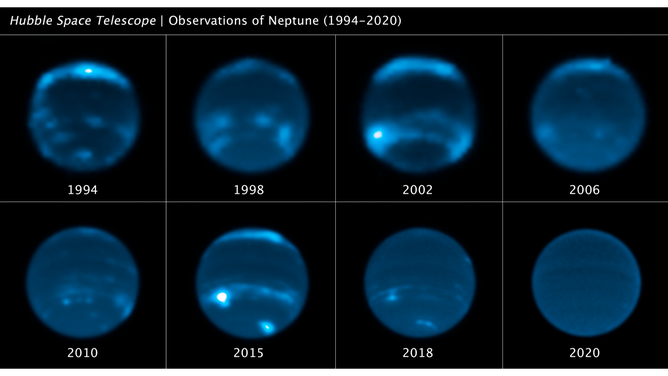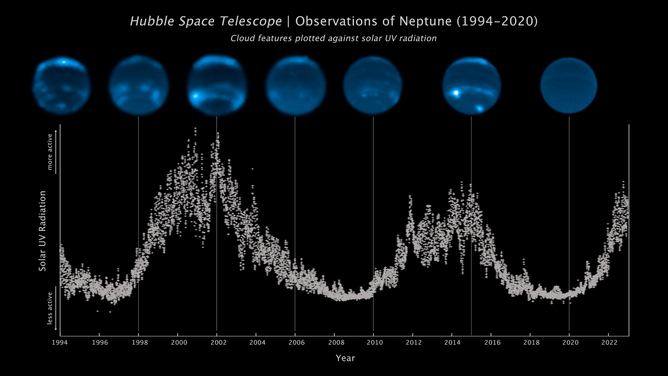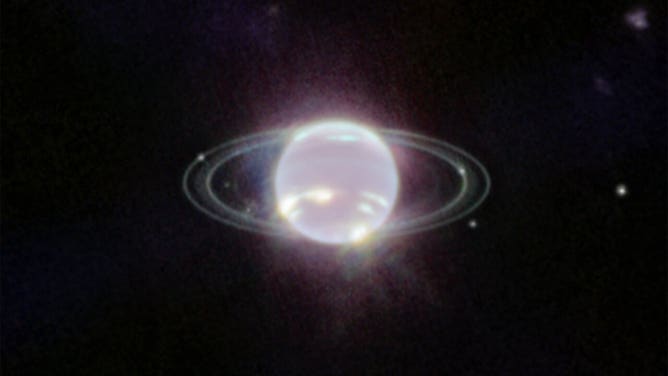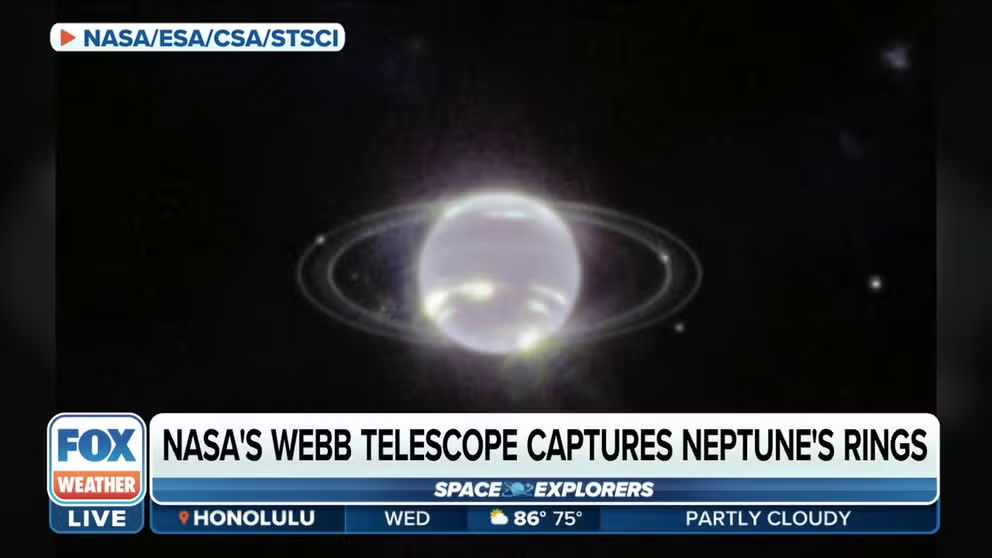Cloudy weather on Neptune influenced by solar cycle, Hubble data shows
Thirty years of Hubble Space Telescope observations and ground-based telescopes in Hawaii and California helped astronomers link Neptune's weather patterns to the 11-year solar cycle. At 3 billion miles from the Sun, solar cycles still influence cloud cover on the giant blue planet.
NASA Webb telescope captures photos of Neptune
NASA's Webb telescope was able to photograph Neptune and its rings capturing the clearest photo of the planet in over 30 years.
Even as the farthest planet from the Sun, the weather on Neptune is still driven by influences from the Sun, according to astronomers after studying 30 years of clouds on the big blue world.
Clouds form on Neptune through photochemistry high in the upper atmosphere and from storms deep within the planet's atmosphere.

This sequence of Hubble Space Telescope images chronicles the waxing and waning of the amount of cloud cover on Neptune from 1994 to 2020. ( Image Credits: NASA, ESA, Erandi Chavez (UC Berkeley), Imke de Pater (UC Berkeley))
(NASA)
Neptune's forecast in the next few years will include more photochemistry clouds as the Sun's magnetic field performs a flip at the end of the 11-year solar cycle. Astronomers know this after monitoring Neptune's cloud cover using observations by the W. M. Keck Observatory in Hawaii, data from the Lick Observatory in California and analyzing nearly 30 years of Hubble Space Telescope observations. Their findings were published in the scientific journal Icarus.
As the Sun reaches the peak of its solar cycle, activity ramps up with more sunspots and increasing solar flares resulting in geomagnetic storms on Earth. On Neptune, the rise and fall of solar activity appear to influence the cloud cover about two years after peak solar activity, according to the study.
NASA said that observations show changes in Neptune's brightness appear to be in sync with the disappearing and reappearing clouds along with the solar cycle.
LONELY NEPTUNE'S RINGS SHINE BRIGHT IN JAMES WEBB SPACE TELESCOPE IMAGES
"These remarkable data give us the strongest evidence yet that Neptune's cloud cover correlates with the Sun’s cycle," said Imke de Pater, emeritus professor of astronomy at UC Berkeley and senior author of the study. "Our findings support the theory that the Sun's UV rays, when strong enough, may be triggering a photochemical reaction that produces Neptune’s clouds."

This sequence of Hubble Space Telescope images chronicles the waxing and waning of the amount of cloud cover on Neptune. The Sun's level of ultraviolet radiation is plotted in the vertical axis. The 11-year cycle is plotted along the bottom from 1994 to 2022. (Image credits: NASA, ESA, LASP, Erandi Chavez (UC Berkeley), Imke de Pater (UC Berkeley))
(NASA)
The cloud cover translated into a plot graph helps paint the picture of the solar cycle's influence. Images of Hubble's cloud observations at the top show the cloud abundance at peak solar activity detailed along the graph's vertical axis.
HOW THE TELESCOPE BECAME OUR WINDOW INTO THE UNIVERSE
According to NASA, more research is necessary to understand better the deep atmospheric clouds versus the photochemically produced clouds, which take more time to form.
Astronomers are now using Neptune observations from the James Webb Space Telescope to continue their research.

Webb’s Near-Infrared Camera (NIRCam) image of Neptune, taken on 12 July 2022, brings the planet’s rings into full focus for the first time in more than three decades. The most prominent features of Neptune’s atmosphere in this image are a series of bright patches in the planet’s southern hemisphere that represent high-altitude methane-ice clouds. (Image: NASA, ESA, CSA, and STScI)
"We have seen more clouds in the most recent Keck images that were taken during the same time NASA's James Webb Space Telescope observed the planet; these clouds were in particular seen at northern latitudes and at high altitudes, as expected from the observed increase in the solar UV flux over the past approximately 2 years," de Pater said.
The Sun is currently in an active period in its solar cycle, with Solar Maximum in 2024.
